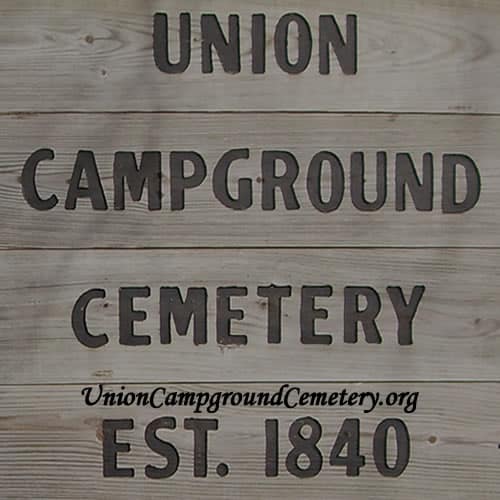UNION CAMPGROUND CEMETERY
This old, abandoned cemetery is in a heavily wooded area on a hilltop overlooking the Little Sac River northeast of Springfield. In 1840 when the cemetery was established, the distance by wagon from the heart of the small village of Springfield was some six or seven miles. At present, it is only a very short distance from the Springfield city limits.
LEGAL DESCRIPTION
Union Campground Cemetery is located in the W. of Lot #5, NW fractional quarter of Section 3, Township 29, Range 21, Greene County, Missouri. The trustees of the Cumberland Presbyterian Church purchased 39.6 acres of land September 29, 1840, from Joseph T. Morton and his wife, Lucinda. The following were listed as trustees: Josiah Danforth, William Dizard (Dysart), Alexander Younger, C. C. Williamson, and Horace Snow.
An indenture under date of December 22, 1866, reveals the trustee of the church (name of the particular church is unknown) sold all the above land with the exception of the three acre graveyard. Trustees were: C. C. Williamson, R. J. Sims, W. P. Dysart, James Harkness, and Horace Snow.
At the time of the sale, the boundaries of the graveyard were described in this way: “Commencing at the brow of the hill on west line of the above tract, running thence east along the brow of the said hill twenty rods thence south twenty-four rods thence west twenty rods thence north twenty-four rods to the place of beginning.”
When a survey was made of the cemetery in 1994, this description proved to be a challenge because Highway 65 had been constructed in the 1980s. The portion of the highway immediately to the west boundary of the cemetery had eradicated the original description “brow of the hill.”
CAMPGROUND MEETINGS
When research began on Union Campground cemetery, the question was raised about the amount of land the trustees purchased in 1840. Why the need for so much land to perhaps build a church and establish a cemetery? The answer was found in an unexpected way. In a history of the Cumberland Presbyterian Churches of Missouri, compiled by the Rev. Eva Hughs, some very old minutes were quoted of the Pleasant Valley Church in Wright County, Missouri. In the minutes, dates and meeting places for the Springfield Presbytery were given and Union campground, Greene County, Missouri, was listed as a meeting place for September, 1851. This mention of Union Campground is the first documented evidence that a campground existed.
A primary evangelism program in the Cumberland Presbyterian Church over the years was the camp meeting. In all probability, the main purpose for the land purchase (39.6 acres) was for permanent camp meeting grounds rather than for a church. The open air meeting experience required ample space for great numbers of people to gather to continue their religious exercises day and night.
THE CHURCH
Past generations failed to identify the exact location of the church structure. Some families theorize the church was to the south of the cemetery; no parts of a foundation have been discovered. The structure burned many years ago and the circumstances and the exact date remain a mystery.
Records have not been found to establish if the church and/or cemetery were ever incorporated or if the cemetery was ever owned by any other entity besides the Cumberland Presbyterian Church. (It might be noted here that some churches of that era assumed the name, “Cumberland” but were never affiliated with the mainline denomination.) We can not determine who the trustees were at the time of the fire or who the minister might have been.
ARCHAEOLOGICAL SURVEY
In November 1993, Patsy Denton Corbett, from the SMSU (now MSU) Center of Archaeological Research, explored the cemetery. Noting the environmental setting of the cemetery location, she noticed the presence of prehistoric lithic flakes and a primary biface fragment (the collection is stored as the MSU center for Archaeological Research). These findings indicate the Union Campground Cemetery had apparently been occupied by humans prior to the early 1800s when the area had been a campground for Presbyterians and the cemetery that was later established. Without further archaeological testing, no conclusion can be reached as to the prehistoric use of the area. Location on a hilltop and slope adjacent to an intermittent stream suggests that it was used as a hunting and/or camp site for the prehistoric occupants. Results from this survey are now recorded as Missouri Archaeological and Historical Site 23 (MO) GR9 (Greene Co) 926 (site in Greene County).
BURIALS
Burial activity seemingly continued until the mid-1920s. Reading made of tombstones by John and LeMerle Cochran in the 1960s and those made by the Ozarks Genealogical Society in the 1980s verify the possibility of at least 200 burials.
Careful and painstaking documentation has been done the past several years on the individuals buried in the cemetery. From the names and dates recorded on the few remaining tombstones, and from old newspaper accounts and funeral home records, 84 burials are now officially recognized. Families have told of 19 other possible burials, and these have been recorded but documentation has not been established.
This cemetery appears to have been racially integrated at a very early date. Records reveal 18 African-American people laid to rest within its borders. It is believed to be among the first cemeteries in the area to not only have been racially integrated but there were also no separate burial areas within the cemetery itself between races.
Throughout the years of abandonment many acts of vandalism occurred. Forces of nature added to the deterioration as did the presence of livestock.
CIVIL WAR BURIALS
From numerous families the same story often emerges: Union soldiers are said to be buried in Union Campground Cemetery. Troops were reported to have camped on the nearby campground and as deaths occurred, probably from disease rather than from war wounds, the remains were buried in the cemetery. These burials have not been documented. Research continues in this regard.
